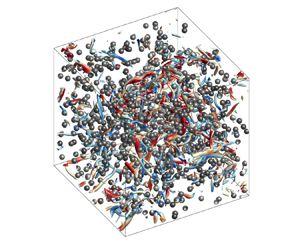Article contents
Decay rate of homogeneous isotropic turbulence laden with finite-size particles
Published online by Cambridge University Press: 13 September 2024
Abstract

This study conducts particle-resolved direct numerical simulations to analyse how finite-size spherical particles affect the decay rate of turbulent kinetic energy in non-sustained homogeneous isotropic turbulence. The decaying particle-laden homogeneous isotropic turbulence is generated with two set-ups, i.e. (1) releasing particles into a single-phase decaying homogeneous isotropic turbulence and (2) switching off the driving force of a sustained particle-laden homogeneous isotropic turbulence. With both set-ups, the decay of turbulent kinetic energy follows a power-law when the flow is fully relaxed, similar to their single-phase counterparts. The dependence of the power-law decay exponent  $n$ on the particle-to-fluid density ratio, particle size and volume fraction is also investigated, and a predictive model is developed. We find that the presence of heavier particles slows down the long-time power-law decay exponent.
$n$ on the particle-to-fluid density ratio, particle size and volume fraction is also investigated, and a predictive model is developed. We find that the presence of heavier particles slows down the long-time power-law decay exponent.
- Type
- JFM Papers
- Information
- Copyright
- © The Author(s), 2024. Published by Cambridge University Press
References
- 1
- Cited by



